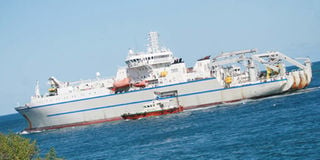Exclusive: Inside the Seacom undersea cable-laying ship

KPA tugboat escorts the fibre optic vessel the Mv.Tyco Resolute Majuro while she was leaving the port of Mombasa. PHOTO/LABAN WALLOGA
What you need to know:
- Vessel has a distinct mechanical feel to it
Setting foot inside the docked cable ship Tyco Resolute is a nauseating experience as you come from the hot and humid air of Kilindini harbour into an even hotter glaringly white interior where running generators drown out our voices.
The slow. deliberate and mean-looking security guards who will not let you aboard without your national identity card despite your being here by invitation doesn’t help matters.
There are Britons, Filipinos and Italians among the crew of the Montevideo, Uruguay-based vessel. The Kenyans are on board on a learning mission.
The floor is sopping wet, and the movement of the crew in orange overalls and high black boots makes the entire experience seem a mechanical world away from the luxurious feel of cruise ships.
Welcome board the Tyco Resolute, one of the ships laying the Seacom fibre optic cable along Africa’s riskiest coastline.
Last month, Kenyans onshore eagerly awaiting the arrival of cheaper internet service felt the effect of the omnipresent threat of piracy off the Kenyan and Somali coasts when an investor in the cable project balked.
Seacom then acknowledged that the project expected to have gone live on June 27, was a month behind schedule as Somali pirates continued to cause havoc on the high seas. Seacom went live last Thursday.
The piracy menace has also seen marine insurance premiums escalate due to the risk associated with eastern Africa coastline.
Piracy again was to blame when The East Africa Submarine cable project (Teams) re-routed 200 nautical miles off the Somali coast.
“The advice we have is that it should be moved further (but) should not impact the delivery date,” said Information and communication PS, Bitange Ndemo during the Teams Ltd subscription agreements signing ceremony earlier this year.
What most Kenyans don’t realise is what it takes to bring the cable ashore and the specialised tasks involved in the drive to get the country and the region connected digitally to the world by fibre optic cable.
Considerable investment has gone into security in the world’s most dangerous ocean waters in order to maintain progress for the Seacom project run by Tyco Telecommunications.
Both the ship’s Captain Alejandro Toimil and the Seacom onboard representative Captain Franklin Kitt acknowledged that pirates were their biggest concern when this interview was conducted a day before Easter (April 12) and embargoed pending the sailing of the ship beyond the shark-and-pirate-infested waters off the Somalia coast.
“Our best time is when a project is completed,” said Capt Toimil as the ship sailed north towards Somalia after taking on fresh supplies in Kenya. “We try to keep the schedule, but at times there are problems like this one.”
The ship had sailed from Cape Town via Maputo and Dar es Salaam to Mombasa.
He said his bosses at Tyco Telecom automatically charged Seacom Sh1 million a day for any delays, so taking chances was out of the question.
The Tyco Resolute is owned by Tyco Telecommunications which operates one of the largest fleets of cable ships in the world; it is registered in The Marshall Islands.
She is described as a satellite-controlled dynamic decision vessel commanded by Capt Toimil since 2002 when she was built.
To guard the ship from pirate attacks Seacom took on eight former US Marines as additional security. They carried out drills as the situation demanded.
Suspicious
Further, the ship is secured with razor wires as well as long-range acoustic devices that can send out high frequency signals that can make pirates--and the occasional fisherman--sick.
“We monitor any suspicious movement within a two-mile radius of the ship. If the other vessel does not respond, there is an immediate lockdown, and the ex-soldiers take charge,” said Capt Kitt, who explained revealing that a normal contract for a captain and crew is 60 days onboard and 60 days off.
For the project handlers, the snaking of the cable along the eastern coast of Africa had its firsts and its complexities.
According to Capt Kitt, a submarine cable consultant and ex-cable ship commander, Seacom has many branching units, each heading to a different country, unlike other cables that are branchless.
When sailing, the Tyco Resolute does 260 kilometres a day of cable ‘ploughing’.
Its project equipment includes a 40-tonne cable drum with four tanks that carry 2,500 kilometres on each cable tank.
Cable is paired up for a receiving and a transmitting fibre. Engineers laying the cable have to ensure that the set up is as straight as possible for faster transmission of information, meaning the route architecture and laying the cable is delicate and strenuous.
Initially, Fugro Seafloor Surveys Inc, an international firm with expertise in marine geology and geophysics, swath mapping, site investigations, desktop studies and sonar-related engineering, did the project architecture.
It is little wonder most Kenyans will be hearing about this technology for the first time this year. More jargon is expected as the implications of the technology begin to sink in.
But it is the unusual silence and mistrust among cable players that is stifling information on the real progress of the projects.
Nevertheless, as the last entrant in the cable project said earlier, the real job of recouping return on investment begins next year after the landing ‘noise’ settles.
“The fibre optic explosion is a marathon, not a sprint. It is who has got the long term business plan to make this work,” Chris Wood, chief executive of West India Ocean Cable Company (WIOCC), the company that owns the East African Submarine Cable (EASSy) project expected to land next June, told the Smart Company, our weekly sister pullout.




